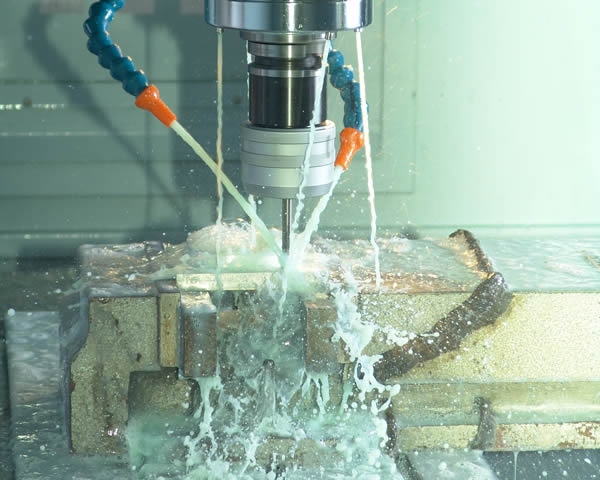10 Tips for Minimizing Breakage of Micro-Mills
and Other Tiny Cutters
Over time certain questions and queries start to stand out, and one I hear a lot about is that machinists are breaking their delicate micro-mills and other tiny cutters too often, and they’d like some pointers on how to avoid it. First thing is first, you need to have proper feeds and speeds for these cutters. Cutters smaller than 1/8″ or about 3mm live in a different world than most of our cutters are used to. The feeds and speeds formulas and calculations that work reasonably well for larger cutters need quite a bit of adjustment for smaller cutters to account for these changing conditions. For example, the geometry at these scales is such that the rake on the cutters is almost always negative. Our G-Wizard feeds and speeds software takes all this into account, and is well-suited to providing feeds and speeds for your tiny cutters.
For best results though, you have to go beyond the feeds and speeds. Here are a few thoughts of where to look for problems when you’re breaking small cutters:
 1. Never reduce the spindle rpms much without reducing feedrate first. Reducing the rpms balloons the chipload, and it is chipload that breaks cutters. Too much rpm merely dulls them sooner.
1. Never reduce the spindle rpms much without reducing feedrate first. Reducing the rpms balloons the chipload, and it is chipload that breaks cutters. Too much rpm merely dulls them sooner.
2. Small hobby machines typically have more spindle runout than expensive pro-CNC’s. This is a real problem when micro-milling because you should think of runout as a % of the cutter’s diameter. Hence a small cutter tolerates very little runout, and the smaller the cutter, the less runout that can be tolerated. Even pro-grade CNC machines can run into this problem over time as bearings start to fail. Runout can also be made worse by your tool holder. I had a brand new ER32 collet one time that turned out to be bad. It looked perfect, but I was breaking 1/8″ cutters in it right and left. I was convinced my cheap collet chuck was at fault, but I eventually tracked it down to the brand new collet. Replacing it immediately improved my results. It’s pretty hard to accurately measure your runout on tiny endmills, but it is important to keep this source of trouble in mind. One last thought on runout. I mentioned it is too much chipload that breaks cutters. Runout places most of the work on just a few or even one flute depending on how the flute is oriented relative to the direction of the runout. Hence, a lot of runout, as a % of tool diameter, is increasing your chipload by that same %. If you’re already close to the “edge”, you’ll break the cutter just as surely as dialing up more chipload by any other means would.

3. Probably the number one issue for hobbyists is clearing chips. I always cringe when I see a picture with a lot of chips piled around the cutter. Recutting the chips and trying to force the new chips past the pile of old ones is really hard work on your poor old cutter. Since hobbyists don’t often have good flood coolant (i.e. the kind where looking in through the door of the enclosure it looks like a car wash, LOL), chips sometimes pile up even with a simple flood system. I prefer either a lot of flood (e.g. the carwash), or if I can’t have that, a really strong jet of air augmented with a little mist for sticky materials like aluminum. If you train yourself to be paranoid about chips in the cutting area, you’ll immediately see benefits in cutter life and surface finish.
4. Be wary of tool deflection. G-Wizard lets you calculate your deflection and even optimize cuts to hold to deflection limits. Deflection is just like runout for small cutters, and it becomes easy to forget about having too much tool stickout because the darned things are so small it seems like only a small amount protrudes.
5. G-Wizard has some specific features for small machines that are particularly germane to small cutters. If you fill out the hardware profile under Setup completely, tell it to compensate for machine weight. Just click the “Adjust” button by spindle HP to turn on that option. What this does is to “de-rate” your spindle HP from a particularly light machine like a Sherline or a Taig so that the HP relative to the weight of the machine and its envelope (total travels) is commensurate with full size CNC mills. Like tool deflection, if the machine is flexing around, that isn’t helping the little cutter.
6. Keep your setup and workholding as rigid as possible.
7. Don’t “baby” the cutter on chipload lest you be cutting so little that the cutter is rubbing instead of cutting.
8. Use tools with an odd number of teeth, such as a 3 flute endmill. They deliver less vibration and more chip clearance.
9. Try a serrated rougher if you have a lot of material to remove, though in most cases, you’ll use a regular EM for both roughing and finishing.
10. Consider HSS tools instead of carbide–they’re less brittle and can “flex” a little more.
Article Resource blog.cnccookbook.com
Article Resource blog.cnccookbook.com







0 σχόλια:
Post a Comment